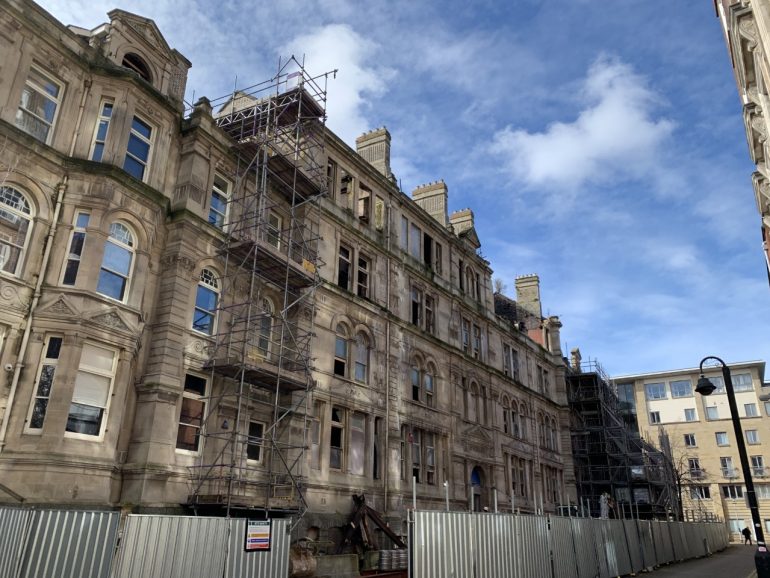Footage reveals the extent of damage caused at the historic Cardiff Bay building
THE future of the Coal Exchange building in Cardiff Bay is once again in doubt after footage emerged of the extent of damage caused by a burst water pipe.
On February 22, the hotel was forced to ask guests to leave and close its doors.
The grade II listed building is undergoing extensive construction work to repair the damage, with sections of the building covered by scaffolding.
According to The Coal Exchange Hotel, which owns the building, parts of the north side of the building are being removed due to safety issues.
What’s being done to fix it?
The Coal Exchange Hotel said the north side of the building had sustained structural damage caused by pressure built up from the burst water pipe.
As a result, parts of the the building are being removed to ensure the building’s safety.

The Coal Exchange Hotel said it had informed Cadw, the branch of the Welsh Government responsible for the preservation of historic buildings.
A spokesperson for Cadw confirmed it had been in contact with the building’s owners.
“At the request of Cardiff Council, controlled partial demolition has taken place to make the structure safe,” they said.
Cardiff Council, which is responsible for administering the regulatory controls for listed buildings, declined to comment.
Why does it matter?
Concern over the site’s future has grown since the footage emerged.
One social media user said: “I realise it’s only a building but I do love our heritage and this for me is sad.”
Another said: “This is a sad end to a glorious, storied building. This should be a thorn in the side of Cardiff Council for generations to come.”
While another asked: “How was this allowed to happen?”
A spokesperson for the Victorian Society, a charity that helps preserve Edwardian and Victorian buildings, said “these (types of) buildings matter”.
“The Coal Exchange on Cardiff’s Mount Stuart Square is one of Wales’s most important landmarks: a Grade II* listed building dating from 1883 when Cardiff was at the centre of the international coal trade”.
https://www.google.com/maps/d/edit?mid=10rlb6z9WFQneBYeeHIbuUXsQXMdNNKw&usp=sharing
When things are considered to be important, it’s because they’re important historically or architecturally. They may have somebody famous who has lived there or (like the Coal Exchange) are linked to the social history of the area.”
The Victorian Society told The Cardiffian that it was originally consulted in 2007 about plans to demolish the building and had advocated for its continued preservation.
“We’re in the middle of a climate crisis, and basically if you take these buildings down then it’s worse for carbon emissions than if you keep it and sensible reuse it,” said the spokesperson.
A site rich in history
The Coal Exchange was built in 1884 and officially opened in 1888. It quickly cemented itself as a key hub in the global coal trade during the late 19th and early 20th century.
The building’s floors grew into a hive of business, with coal magnates and ship owners from the nearby dock arranging deals in the trading hall. The world’s first £1 million cheque is thought to have been written there in 1904.
At its peak, Cardiff was one of the largest coal ports in the world. However the hall’s fortunes would mirror the coal trade, and once the black gold stopped being of value, so did the hall which shut its doors in 1958.
Ahead of the 1979 devolution referendum in Wales, the building was mentioned as a potential future site for the proposed Welsh Assembly however the outcome of the referendum saw the Welsh public vote against devolution.
As part of the plans a heavily reinforced carpark was constructed with the intention of it doubling as a possible nuclear shelter.
The building reopened in 2001 as a music venue, hosting the likes of the Arctic Monkeys, Manic Street Preachers and Stereophonics before closing again in 2013 due to safety issues.
It reopened in 2017 as a hotel.



